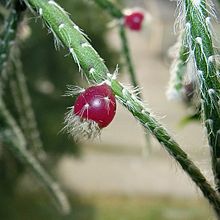- Rhipsalis
-
For the algae, see Halimeda.
- "Mistletoe cactus" redirects here. This may also mean specifically Rhipsalis baccifera, or, more generally, other Rhipsalideae.
- "Cactus mistletoe" is Tristerix aphylla, a Chilean species of mistletoe, whose preferred hosts are two species of cactus.
Rhipsalis 
Flowering Rhipsalis cereuscula Scientific classification Kingdom: Plantae (unranked): Angiosperms (unranked): Eudicots (unranked): Core eudicots Order: Caryophyllales Family: Cactaceae Subfamily: Cactoideae Tribe: Rhipsalideae Genus: Rhipsalis
Gaertn.Species Numerous, see text
Synonyms Cassytha Mill. (non L.: preoccupied) Erythrorhipsalis A.Berger
Rhipsalis is a genus of epiphytic cacti. They are typically known as mistletoe cacti. The scientific name derives from the Ancient Greek term for wickerwork, referring to the plants' habitus. Rhipsalis is one is part of the tribe Rhipsalideae within the subfamily Cactoideae of the Cactaceae. It is the largest and most widely distributed genus of epiphytic cacti. The genus was described by Joseph Gaertner in 1788. But when he described the plant, he had in fact not realised it was a cactus. Instead, he assumed to have found a new species of Cassytha, a parasitic Lauraceae. Hence, Cassytha is often indicated as a generic synonym for Rhipsalis, although this is not the case, since this generic name had been applied for a completely different genus in a different plant family.
Contents
Ecology and distribution
Rhipsalis is found as an epiphyte in tropical rainforests, some species may also grow epilithic or, rarely, terrestrial. The genus is found widely in Central America, parts of the Caribbean and a great part of northern and central South America. The center of diversity of Rhipsalis lies in the rainforests of the Mata Atlantica in southeastern Brazil. It is found throughout the New World, but additionally in tropical Africa, Madagascar, Sri Lanka. It is the only cactus with a natural occurrence outside the New World.
 Rhipsalis pilocarpa fruit
Rhipsalis pilocarpa fruit
Morphology
The morphology of Rhipsalis is very variable. The plants can grow mostly pendent, few grow more or less upright or sprawling. There are three main stem shapes: terete, angular and flattened. The stems are succulent, but the degree of succulence varies between the species. Some have very thick stems (e.g. Rhipsalis neves-armondii), whereas other have very thin, filiform stems (e.g. Rhipsalis baccifera, Rhipsalis clavata). In the majority of species, spines are missing or occur only in the juvenile stage (this is most prominent in Rhipsalis dissimilis). Rhipsalis pilocarpa has stems and fruits densely covered by bristes, making this species easily distinguisable from all other Rhipsalis. The flowers are borne lateral or apical and are actinomorphic with a varying number of perianth segments, stamens and carpels. They are small, usually about 1 cm in diameter, white or whitish in most species. Yellowish flowers occur in R. dissimilis and R. elliptica and R. hoelleri is the only Rhipsalis species with red flowers. The fruits are always berries, they are whitish or coloured pink, red or yellow.
Species
Based on the latest taxonomic treatment in the New Cactus Lexicon (Hunt et al. 2006), 35 species of Rhipsalis are recognised.
- Rhipsalis agudoensis N.P. Taylor
- Rhipsalis baccifera (J.S.Muell.) Stearn
- Rhipsalis burchellii Britton & Rose
- Rhipsalis campos-portoana Loefgr.
- Rhipsalis cereoides Backeb. & Voll
- Rhipsalis cereuscula Haw.
- Rhipsalis clavata F.A.C.Weber
- Rhipsalis crispata Pfeiff.
- Rhipsalis cuneata Britton & Rose
- Rhipsalis dissimilis K.Schum.
- Rhipsalis elliptica G.Lindb. ex K.Schum.
- Rhipsalis ewaldiana Barthlott & N.P. Taylor
- Rhipsalis floccosa Salm-Dyck ex Pfeiff.
- Rhipsalis grandiflora Haw.
- Rhipsalis hoelleri Barthlott & N.P.Taylor
- Rhipsalis juengeri Barthlott & N.P.Taylor
- Rhipsalis lindbergiana K.Schum.
- Rhipsalis mesembryanthemoides Haw.
- Rhipsalis micrantha Kunth
- Rhipsalis neves-armondii K.Schum.
- Rhipsalis oblonga Loefgr.
- Rhipsalis occidentalis Barthlott & Rauh
- Rhipsalis olivifera N.P.Taylor & Zappi
- Rhipsalis ormindoi N.P.Taylor & Zappi
- Rhipsalis pacheco-leonis Loefgr.
- Rhipsalis pachyptera Pfeiff.
- Rhipsalis paradoxa Salm-Dyck
- Rhipsalis pentaptera Pfeiff.
- Rhipsalis pilocarpa Loefgr.
- Rhipsalis pulchra Loefgr.
- Rhipsalis puniceodiscus G.Lindb.
- Rhipsalis russellii Britton & Rose
- Rhipsalis sulcata F.A.C. Weber
- Rhipsalis teres Steud.
- Rhipsalis trigona Pfeiff.
Literature
- E. F. Anderson (2001): The Cactus Family. Timber Press.
- W. Barthlott & N.P. Taylor (1995): Notes towars a Monograph of Rhipsalideae (Cactaceae). Bradleya 13, pp. 43–79.
- W. Barthlott (1983): Biogeography and evolution in neo- and palaeotropical Rhipsalinae (Cactaceae). In: Kubitzki, K. (Ed.) Proc. Int. Symp. Dispersal and Distribution, Sonderbd. naturwiss. Ver. Hamburg 7: 241-248.
- J. Hugo Cota-Sánche [Vivipary in the Cactaceae: Its taxonomic occurrence and biological significance], Flora - Morphology, Distribution, Functional Ecology of Plants ; Volume 199, Issue 6, 2004, Pages 481-490 doi:10.1078/0367-2530-00175
- D. Hunt, N. Taylor, G. Charles (2006): The New Cactus Lexicon. dh books.
- N. P. Taylor, D. Zappi (2004): Cacti of Eastern Brazil. Kew Publishing.
Categories:- Rhipsalis
- Epiphytes
Wikimedia Foundation. 2010.
